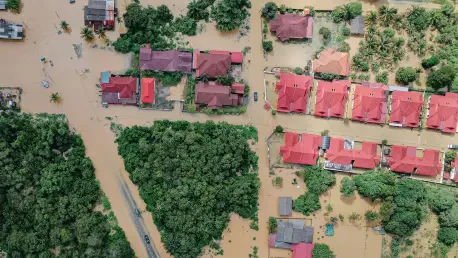In a nation increasingly battered by extreme weather, a staggering $17.1 billion annual shortfall in flood insurance coverage for single-family homes across the United States has emerged as a silent crisis threatening millions of households, insurers, and the broader real estate market. This gaping hole in financial protection stems from outdated risk models, homeowner complacency, and the relentless advance of climate change, which amplifies the frequency and severity of flooding. While many assume flood risks are confined to designated hazard zones, the reality paints a far grimmer picture, with vast numbers of properties left exposed to devastating losses. The disconnect between actual danger and adequate coverage not only jeopardizes individual livelihoods but also signals a systemic failure with profound economic implications. This exploration uncovers the depth of the problem, its disproportionate impact on vulnerable groups, and the pressing need for innovative solutions to safeguard communities against an escalating threat.
Uncovering the Scale of Underinsurance
The magnitude of the flood insurance gap is staggering, with estimates from the Federal Reserve Bank of Philadelphia indicating that 70% of annual flood losses—totaling $17.1 billion—remain uninsured across the country. This shortfall is not confined to areas officially marked as high-risk by FEMA’s Special Flood Hazard Areas. A striking example comes from Texas, where 93% of properties in flood-exposed regions outside mapped floodplains lack any form of coverage, even after experiencing severe flash floods recently. Research from Neptune Research Group further reveals that 85% of at-risk homes nationwide are inadequately protected, underscoring a critical mismatch between current risk assessments and the evolving nature of climate-driven disasters. This widespread underinsurance exposes a fundamental flaw in how flood threats are perceived and addressed, leaving millions of homeowners unprepared for the financial devastation that often follows unexpected deluges.
Beyond the raw numbers, the insurance gap reflects a deeper systemic issue tied to outdated methodologies that fail to account for shifting weather patterns. Many homeowners, particularly those outside designated hazard zones, underestimate their vulnerability, assuming floods are a distant concern. Yet, as climate change accelerates, flooding events are becoming more unpredictable, striking areas previously deemed safe. The failure to update flood maps and risk models in real time exacerbates the problem, allowing the gap to widen year by year. Compounding this is a lack of awareness or financial means among property owners to secure policies, especially in regions where mandatory insurance isn’t enforced. This dangerous combination of ignorance and inaction creates a ticking time bomb for the housing sector, where a single catastrophic event could trigger widespread economic fallout for unprepared communities.
Economic and Social Fallout of the Gap
The human cost of this $17.1 billion insurance shortfall falls heaviest on low-income households, who represent 90% of the underinsured population in flood-prone areas. For these families, a single flood event can wipe out savings, with losses often surpassing 20% of their yearly income, plunging them into long-term financial hardship. The burden is not just personal but systemic, as the National Flood Insurance Program (NFIP), which shoulders only 35% of total flood damages, struggles under a crushing $20 billion debt. This financial strain limits the program’s ability to support recovery efforts, leaving many to fend for themselves. Meanwhile, the real estate market feels the impact as properties in high-risk zones appreciate at a slower rate compared to safer areas, hinting at a potential economic correction estimated between $1.7 and $2.7 trillion if flood risks become more transparent to buyers and investors.
This economic ripple effect extends beyond individual homeowners to entire communities, where the lack of coverage undermines local stability. In flood-prone regions, the inability to recover quickly from disasters stifles economic growth, as businesses shutter and families relocate. The disparity in impact is stark, with wealthier households often able to absorb losses or secure private insurance, while marginalized groups face disproportionate ruin. Additionally, the stagnation in property values signals a shift in market perception, as buyers and lenders grow wary of flood risks, potentially reshaping housing demand. This dynamic threatens to devalue entire neighborhoods, further eroding community resilience. The insurance gap, therefore, is not merely a financial statistic but a profound social inequity, highlighting the urgent need for targeted interventions to protect the most vulnerable and stabilize affected markets.
Straining Insurers and Shifting Market Trends
Insurers are grappling with the fallout of escalating flood claims, with many choosing to withdraw from high-risk markets like Florida and Louisiana through widespread policy non-renewals. Historical data paints a grim picture: between 2010 and 2023, insurers covered just $50 billion of $144 billion in flood-related damages, leaving a staggering $94 billion shortfall borne by homeowners and taxpayers. This retreat widens the coverage gap, as fewer providers are willing to take on the mounting risks posed by climate-driven flooding. The strain on the industry also reverberates through the real estate sector, where mortgage lenders are increasingly limiting exposure in vulnerable areas by tightening lending criteria or offloading risk. Such actions contribute to a noticeable stagnation in property values, signaling that flood risk is beginning to reshape market dynamics in profound ways.
The insurance industry’s withdrawal is a clear indicator of an unsustainable system buckling under the weight of climate change. As claims costs soar, the traditional model of underwriting flood risk becomes unviable, pushing insurers to rethink their strategies or exit entirely. This creates a vicious cycle, where reduced availability of coverage drives up premiums for remaining policies, further discouraging homeowners from securing protection. In parallel, the real estate market faces a reckoning, as diminished property appreciation in flood-prone zones reflects growing buyer hesitancy. Lenders, sensing the risk, are also scaling back, which could constrict access to homeownership in affected areas. This convergence of insurer retreat and market shifts underscores a critical tipping point, where the lack of adequate flood protection threatens to destabilize both financial and housing systems on a national scale.
Pathways to Innovation and Systemic Change
Amid the challenges posed by the flood insurance gap, emerging opportunities offer a glimmer of hope through private sector innovation. Companies like CoverHomes and FloodFlash are stepping in with technology-driven, affordable flood insurance solutions, targeting a $24.4 billion annual loss pool that remains largely untapped. Additionally, investments in climate resilience are gaining traction, with flood mitigation technologies and retrofitting services projected to grow within a global adaptation market expanding at 12% annually through 2030. These developments signal a potential shift toward more accessible protection for homeowners, while also presenting lucrative prospects for investors willing to navigate the risks of high-exposure regions. However, innovation alone cannot close the gap without broader structural support to ensure widespread adoption and affordability.
Systemic reform is essential to address the root causes of underinsurance and align coverage with actual flood risks. Proposals such as mandatory flood insurance for all mortgages via an opt-out model could significantly boost participation rates. Dynamic flood mapping, leveraging real-time data, offers another critical tool to update outdated FEMA maps and better predict vulnerabilities. Subsidized coverage for low-income households, who face a 90% underinsurance rate, is also vital to reduce inequity and protect the most exposed. While these reforms may introduce short-term regulatory challenges, they hold the promise of creating a more equitable and stable market over time. Companies that adapt by integrating advanced risk assessment tools, such as AI-driven underwriting, are likely to gain a competitive edge. The path forward demands a blend of policy action and private ingenuity to safeguard communities against the rising tide of flood losses.
Building Resilience for Tomorrow
Reflecting on the $17.1 billion flood insurance gap, it becomes evident that this crisis exposes deep vulnerabilities in the U.S. real estate and financial systems, driven by outdated frameworks and intensified by climate change. The severe impact on low-income families and the strain on insurers highlight a pressing inequity and unsustainability that demand attention. As property values falter in high-risk areas, the looming threat of a multi-trillion-dollar market correction underscores the scale of economic risk that has been overlooked for too long. Moving forward, actionable steps like implementing mandatory insurance policies, modernizing flood risk mapping, and supporting innovative private solutions stand as critical measures to bridge this gap. Prioritizing subsidies for vulnerable households and investing in resilience infrastructure can further fortify communities. The lessons learned point to a future where proactive adaptation and bold reforms could transform this hidden financial exposure into an opportunity for stability and equity.









